The MGA With An Attitude
DIPPER SWITCH Fails to Switch, Shorts To Ground -- FT-063
Patterned after Lucas type FS22, but NOT A Lucas Part.
Moss Motors USA 140-900 -- Scarborough Faire 11G200
Replacement part for BMC part number 11G2007
As fitted to a large number of classic cars like; Ford, Morris, Austin, Jaguar, Hillman, Triumph, Allard, Armstrong Siddeley, Bristol, Jensen, MG, Rover, Singer, Triumph, Standard, Sprite, Vauxhall, Wolseley etc.
Known applications:
Austin Healey 100-4 (BN1, BN2) 1953, 1954, 1955, 1956
Austin Healey 100-6 (BN4, BN6) 1956, 1957, 1958, 1959
Austin Healey 3000 (BJ8, BJ7, BN7, BT7) 1959-1967
Austin Healey Sprite (Bugeye model)
Jaguar XK120, XK140, XK150 1948-1961
MG MGA 1955-1962
MGTD, MGTF 1949-1955
Triumph TR2, TR3 1953-1962
On 8/29/2013, Steve Miller wrote:
"Switch the dip switch and POW ... nothing now. I blew my main 25 amp fuse in the brown lead".
Steve was fortunate (maybe) that he had recently installed a main line fuse in the Brown wire feeding power to the control box (more about this fuse below). Original MGA wiring has no fuse in the circuit for headlamps, so the same short to ground in the dipper switch could have burned everything connecting from the battery cable to the dipper switch. That would be Brown wire from starter switch to control box, Brown/Blue from control box to ignition switch, connectors on the ignition switch (if they are Lucar type spade connectors on a replacement switch), and Brown/Blue from ignition switch to dipper switch. If these heavy gauge wires burn they can also take out large parts of the main wiring harness. So this is potentially a very expensive failure which could result from the not-so-expensive faulty dipper switch. Of course it can also leave you with no headlights when zipping down the road in the dark with oncoming traffic.
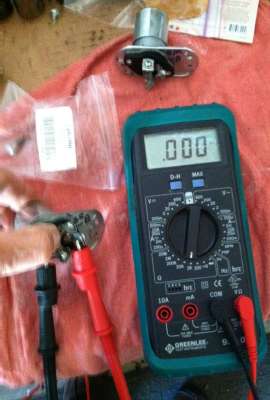

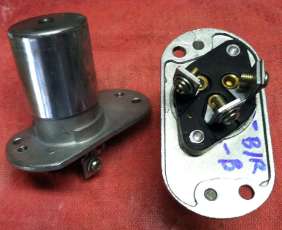
After testing the switch it is determined that on every second operation of the switch it will short the input power terminal (and one of the output terminals) to ground on the switch housing. Two replacement switches were purchased from two different vendors. These switches apparently have the same manufacturing source including the same fault. I still need to identify the vendors so they may be contacted to inform them that they are selling faulty parts. Hopefully the vendors will stop sales immediately and also inform the manufacturer.
Meanwhile, let the buyer beware that a new dipper switch may have this fault. Test the switch with a ohm meter or continuity tester between the center terminal and case ground while operating the switch through at least two complete mechanical cycles. If it will short the input terminal to ground when the switch is depressed, DO NOT INSTALL THIS SWITCH. Inform the vendor immediately, and return any faulty dipper switch to the vendor for refund of the purchase price.
Now note that I have serious reservations about using on in-line fuse in the main power supply wire as noted above, and I do NOT recommend it. If you have a short in the headlight circuit that may blow that fuse, you would lose all power to the car (except the starter motor and maybe the horn). This could leave you sailing town the road in the dark with no lights at all, and a dead engine. If you want to fuse the headlight circuit(s), then install the fuse somewhere in the headlight circuit, not in the main power wire for the whole car.
Addendum, September 4, 2013:
Moss Motors jumped on this as soon as they heard about it. There was an immediate stop on sales of the part, and internal investigation started. Do not be surprised if this part is listed as N/A for a while. Scarborough Fair (source of the second bar part) was also notified, but don't know their reaction yet. Also remember that there are other vendors selling the same part, and those other vendors may not yet be aware of the problem. I have notified a few more of the common suppliers and a few peddlers on eBay that appear to have the same part. No way to contact them all. Please let me know if you may have one of these switches with the same internal ground fault, and if you know who sold it.
Addendum October 25, 2013:
The switch that Steve Miller returned to Moss Motors was opened for inspection. It was found to have one brass contact too close to the case so it would short out on operation. They are adding a Mylar insulation collar inside the case to remedy the situation, and the parts should be available again soon. (I hope the Mylar doesn't wear through with extended use).
Addendum April 28, 2017:
Procured and installed a new dipper switch from Moss Motors on February 18, 2017. On March 27 the new switch was reluctant to switch from high beam to low beam, requiring multiple kicks to do so, and it was getting progressively worse. So this one made only 5 weeks and 4500 miles before internal failure.
 Today (4/28) I exchanged the failed switch and picked up a new one at Moss Motors in Goleta, CA, giving Moss a recommendation to open the failed switch to see why it had failed (which I doubted they would do). I kick cycled the new one 100 times under electrical load, and it seemed to work okay. Today (4/28) I exchanged the failed switch and picked up a new one at Moss Motors in Goleta, CA, giving Moss a recommendation to open the failed switch to see why it had failed (which I doubted they would do). I kick cycled the new one 100 times under electrical load, and it seemed to work okay.
Addendum May 5, 2017:
The headlamp dipper switch we installed last week, after just a few nights in service, was giving us grief, not wanting to dip, as bad as the last one that was failing after five weeks of service. Maybe I should have cycled it 200 times before leaving Moss. This one will have to be returned as well.
Addendum June 19, 2017:
Returned the second failed dipper switch personally to Moss in Goleta, again recommending they open it to determine why they are failing. Picked up and installed the third new one, with not a lot of confidence.
Addendum July 23, 2017:
The third new dipper switch has suddenly failed without notice (5 weeks, 8500 miles), and this time much worse than the prior two. Not only reluctant to switch, but also sometimes (fairly often) shorting to ground during the attempt to switch, requiring another kick to clear the ground short and restore light. Notice this report began four years earlier with shorts to ground, and Moss claiming to have fixed the situation.
 Short to ground kills the headlights (and the dash lights and tail lights). This is scary and dangerous, alternately blinding oncoming drivers then having no lights at all, then maybe blinding oncoming drivers again until the low-beam condition may be restored. It might ultimately result in permanent grounding which could burn up the wiring harness and possibly cause a car fire. Short to ground kills the headlights (and the dash lights and tail lights). This is scary and dangerous, alternately blinding oncoming drivers then having no lights at all, then maybe blinding oncoming drivers again until the low-beam condition may be restored. It might ultimately result in permanent grounding which could burn up the wiring harness and possibly cause a car fire.
 Unfortunately we were on remote roads in Yukon Territory, Canada (large animals roaming in the dark) at the time, so no replacement part handy. Note to self, leave it on low beam and don't touch the switch until it can be replaced. Also try not to drive in the dark with no high beam headlights. Unfortunately we were on remote roads in Yukon Territory, Canada (large animals roaming in the dark) at the time, so no replacement part handy. Note to self, leave it on low beam and don't touch the switch until it can be replaced. Also try not to drive in the dark with no high beam headlights.
Addendum August 2, 2017:
Finally got out of the communications dead zone and managed to call Moss (from Vancouver Island, Canada) to report the bad part. I highly stressed the recommendation to freeze sales of this part until the situation can be corrected. I was advised by the gentleman on the phone from Moss that he did not have the authority to do that, but would file the trouble report with Tech Personnel, and they would be calling me "in a day or two" for more information.
Addendum August 7, 2017:
Doing an autopsy on the failed dipper switch. Not long to drill out two rivets in back and one in front to disassemble the switch, and then a few more minutes to get some photos of the internal bits.
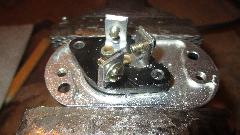
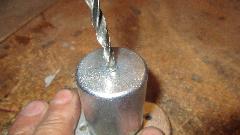
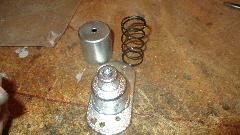
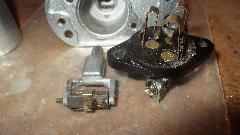 The moving parts are a forked yoke with square neck for alignment in the housing, and a rotating square bobbin carrying the moving electrical contacts. Fixed position parts are the pot metal housing and phenolic rear plate, and three phosphor-bronze spring contact fingers. The center finger is the power input terminal, and it has a hook at the bottom end. When the switch is kicked, the square bobbin is pushed downward where the hook catches a corner of the bobbin to make it rotate 1/4 turn, which in turn presents moving electrical contacts alternately to one or the other of the output fingers.
The moving parts are a forked yoke with square neck for alignment in the housing, and a rotating square bobbin carrying the moving electrical contacts. Fixed position parts are the pot metal housing and phenolic rear plate, and three phosphor-bronze spring contact fingers. The center finger is the power input terminal, and it has a hook at the bottom end. When the switch is kicked, the square bobbin is pushed downward where the hook catches a corner of the bobbin to make it rotate 1/4 turn, which in turn presents moving electrical contacts alternately to one or the other of the output fingers.
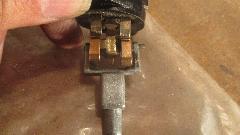
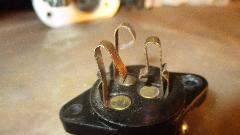
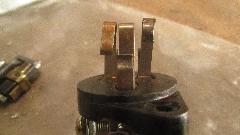
One of the contact fingers was curled up, like maybe the bobbin had over-traveled and caught underneath it before returning upward. The forked yoke with square shank was a very loose fit in the housing, so the yoke could wobble around a lot. The only thing restraining this wobble would be the step cap that was riveted to the top end of the yoke. In some combination of motion the yoke came into contact with one of the output contact fingers, resulting in short to ground on the housing (through the yoke), as witnessed by the badly burned contact and a mating burn mark on the yoke. Additionally, it looks like the ends of the square rotating bobbin may not be exactly perpendicular to the rotational axis, and the two arms of the yoke may not be exactly parallel. Result of all that is binding of the bobbin in the yoke at one point of the rotation. This binding point is illustrated in the picture where the supporting axle pin is lying on the table while the bobbin is still stuck in the yoke.
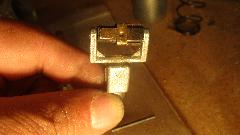
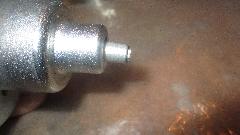
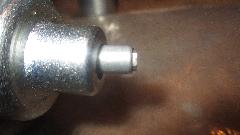
There was a prior report of short to ground. The Moss Motors response (as noted by Kelvin Dodd in a message on a public bulletin board) was reportedly to add a tubular Mylar insulator inside the housing to prevent any moving part from grounding on the housing. This switch certainly had no such Mylar insulator part, so this may be a case of "specification creep" when a successive production batch of parts was not made the same way. That may be a different issue than the fact that these switches have a repeating habit of not switching when actuated. That is, they may have two different failure modes.
This particular switch may be exhibiting a different mode of internal grounding. When the moving yoke wobbles around, one forked side of the yoke came into contact with one of the spring finger electrical contacts, shorting to ground through the yoke to the housing at the square guide shank (and through the cover cap and spring). A mylar tube insulator inside the housing (if there was one there) would not stop this particular grounding path. It appears that the primary problem now is sloppy fit between the housing and the square guide shank of the moving yoke, so the yoke can wobble around too much and touch the electrical contact finger. I don't know if the finger was curled up before the short occured. It could be the bobbin caught the finger and curled it up first, then causing the contact interference with the yoke.
Moss has been notified of this problem, also given reference to these photos and notes, and is looking into it. No word yet if they may or may not have stopped sales of the part.
|